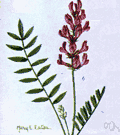crazyweed
Also found in: Thesaurus, Medical, Encyclopedia, Wikipedia.
cra·zy·weed
(krā′zē-wēd′)n.
See locoweed.
[From its toxic effect on some animals.]
American Heritage® Dictionary of the English Language, Fifth Edition. Copyright © 2016 by Houghton Mifflin Harcourt Publishing Company. Published by Houghton Mifflin Harcourt Publishing Company. All rights reserved.
crazyweed
(ˈkreɪzɪˌwiːd)n
(Plants) a US dialect name for locoweed
Collins English Dictionary – Complete and Unabridged, 12th Edition 2014 © HarperCollins Publishers 1991, 1994, 1998, 2000, 2003, 2006, 2007, 2009, 2011, 2014
lo•co•weed
(ˈloʊ koʊˌwid)n.
any of various leguminous plants of the genera Astragalus and Oxytropis, of the southwestern U.S. and Mexico, causing locoism in sheep, horses, etc.
[1875–80, Amer.]
Random House Kernerman Webster's College Dictionary, © 2010 K Dictionaries Ltd. Copyright 2005, 1997, 1991 by Random House, Inc. All rights reserved.
ThesaurusAntonymsRelated WordsSynonymsLegend:
Switch to new thesaurus
| Noun | 1. |  crazyweed - any of several leguminous plants of western North America causing locoism in livestock crazyweed - any of several leguminous plants of western North America causing locoism in livestocklegume, leguminous plant - an erect or climbing bean or pea plant of the family Leguminosae genus Oxytropis, Oxytropis - large widely-distributed genus of evergreen shrubs or subshrubs having odd-pinnate leaves and racemose or spicate flowers each having a pea-like corolla with a clawed petal Oxytropis lambertii, purple loco, purple locoweed - tufted locoweed of southwestern United States having purple or pink to white flowers |
Based on WordNet 3.0, Farlex clipart collection. © 2003-2012 Princeton University, Farlex Inc.